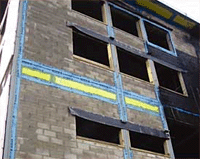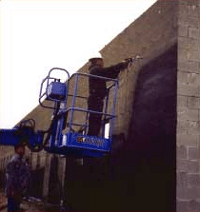Increase Your Revenue with Air Barriers
By Kevin Polk
 Air barriers are becoming more widely recognized as an integral part of the building envelope system, not only to improve the quality of a structure but also to maintain a quality environment within the structure.
Air barriers are becoming more widely recognized as an integral part of the building envelope system, not only to improve the quality of a structure but also to maintain a quality environment within the structure.
Air barriers prevent both infiltration and exfiltration of air within a structure. Air infiltration into a structure allows the passing of air from the exterior to the interior of a structure. This air can contain a variety of contaminants (e.g., smoke, soot, dust), but most commonly ? and certainly most damaging ? is the moisture content.
The Canada Mortgage and Housing has estimated that $500 million is spent annually due to premature deterioration of buildings. Air exfiltration from a structure allows the conditioned air within a structure to escape. The U. S. Department of Energy has concluded that up to 40% of the energy consumed to heat or cool a building is due to air leakage into and out of the structure.
 An effective air barrier is constructed in a cavity wall by using a variety of compatible products to create a comprehensive barrier. These products typically are offered in a fluid-applied membrane or a self-adhering sheet membrane. In conjunction with the membranes, a variety of detail materials are required to address substrate changes, tie-ins and penetrations.
An effective air barrier is constructed in a cavity wall by using a variety of compatible products to create a comprehensive barrier. These products typically are offered in a fluid-applied membrane or a self-adhering sheet membrane. In conjunction with the membranes, a variety of detail materials are required to address substrate changes, tie-ins and penetrations.
Air barrier systems should not be confused with vapor barriers or retarder systems. These systems are designed to control the infiltration of airborne vapor into structures and are rarely 100% effective. They often contain gaps and breaches around fixtures and windows, and are rarely connected at the wall to roof interface.
Air barrier installations are often completed by a waterproofing contractor, painter or specialty trade. However, mason contractors and general contractors are beginning to see the profitability and time savings associated with having the air barrier installed by the mason contractor.
FAQs
Air barriers can be confusing sometimes, so we have assembled a quick list of Frequently Asked Questions concerning the subject matter.
Why should we offer air barrier installation?
By offering the ability to install the air barrier, the mason contractor is creating the opportunity for his or her business to see significant revenue and profit increases per project. Other advantages include:
- Mason contractors are already under contract to build the masonry walls.
- Mason contractors offer a single-source responsibility for the soundness and tightness of the walls.
- There are less scheduling conflicts.
- No questions about wall preparation.
How do we learn to install air barriers?
Most manufacturers of air barrier products offer training and technical support to the customers. The Air Barrier Association of America offers a complete certification course for installers, teaching them the principles and techniques for proper installation.
What air barrier system should we choose?
Since air barriers come in various forms, mason contractors should choose the system that best fits their needs. Spray-applied systems offer the most productive product application. As an installer, it would be beneficial to align with one manufacturer as special equipment and specific techniques are usually required of each individual product and/or system.
What are the start-up costs associated with becoming an air barrier installer?
Depending upon the size of your company and the amount of work available to you, it is important to select a barrier system that is not only approved and accepted, but also fits your budget. Start-up costs range from nominal amounts for installing sheet goods, roller or trowel-applied products up to $25,000 for special equipment to apply spray-on systems.
How much revenue can we expect to make as an air barrier installer?
The price per square foot of an air barrier has a dramatic range depending upon the system specified, the amount of detail work and the size of the project. On a 50,000 sq. ft. building that could mean $.50-$1 per sq. ft. profit that goes into someone else's pocket.
What if air barriers are not required in my area?
If they are not required now, there is a very good chance that they may be soon. A previous article in Masonry (page 26, November 2003) states that 21 states are considering air barrier requirements for their respective codes. Individual architects and engineers are also seeing the value in specifying air barriers. Be prepared.
How do we get started?
Research, get on the Internet, ask local suppliers, and look at the jobs you've done in the past. Find out what products are being used and what products are accepted. Most importantly, contact a manufacturer and ask questions.
About the Author
Kevin Polk is a sales manager at Epro Services, Inc.


















